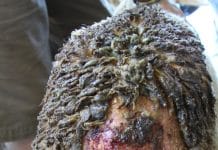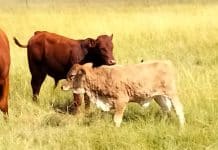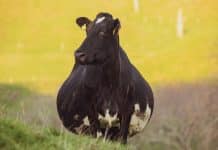
Sheep and goat abscesses are not only painful to the animals they affect, but can have a devastating effect on a producer’s pocket. Two of the most common culprits that cause these unfortunate afflictions are Corynebacterium pseudotuberculosis and Trueperella pyogenes.
C. pseudotuberculosis is a facultative aerobic, gram-positive bacterium that lives in soil. This bacterium is the causative organism of caseous lymphadenitis (CLA) and has been isolated from goats, sheep, horses, cattle, and humans (although to a lesser extent).
T. pyogenes, previously known as Arcanobacterium pyogenes, is a non-motile, facultative anaerobic, gram-positive bacterium. It is an opportunistic bacterium that can cause a diverse range of diseases such as mastitis, liver abscesses, and pneumonia in cattle, sheep, pigs, and goats.
Spread of the bacteria
Normally, these two types of bacteria infect the more susceptible animals in the herd, with infection spreading further via infected animals. C. pseudotuberculosis infections can occur when certain procedures, such as ear tagging, tail docking or castration are performed using unsterilised tools.
T. pyogenes can infect animals through breaks in the skin barrier caused by wounds from ticks, thorns, grass seeds, and weeds. In sheep in particular, grass seeds are known to penetrate the soft skin around the throat, which can lead to abscesses around the tongue and pharynx.
C. pseudotuberculosis
When infected with C. pseudotuberculosis, it takes between 15 and 140 days for an abscess to develop. The infected animals usually show few clinical signs, but when a large number of abscesses develop, animals will lose weight and become lethargic.
C. pseudotuberculosis infection causes abscesses filled with thick yellow-white or green-white pus. A capsule that surrounds the abscess can form in animals suffering from chronic abscesses.
Infection also leads to enlarged lymph nodes and abscessation around the neck and head. In some cases, infection can spread to the lungs; more rarely it can lead to pneumonia, hepatitis, mastitis, orchitis, arthritis, and perinatal mortality. C. pseudotuberculosis infections are commonly associated with wounds caused by shearing.
Bacteria can survive on surfaces for up to ten days – sometimes for more than a year in hay or bedding – and for more than 24 hours in dipping fluid.
T. pyogenes
T. pyogenes is normally found on the mucosal surfaces of healthy animals, such as the urogenital, gastrointestinal, and upper respiratory tracts of cattle, goats, horses, musk deer, pigs, and sheep. Bacteria are also present on thorns, barbed wire, and certain vegetation. The bacteria flourish under wet and cooler weather conditions, and flies are excellent transmitters.
T. pyogenes usually enters the body through damaged tissue. Although abscesses caused by the infection can be formed in almost every organ, they commonly occur at the site of tick bites or wounds, while the mammary glands, central nervous system, regional lymph nodes, respiratory and cardiovascular systems, skeletal system, and the liver can also present with abscesses.
Quite often infections will occur in the genital, gastrointestinal, and upper respiratory tract seeing as those locations naturally harbour high levels of the bacteria. This bacterium may lead to chronic mastitis, post-kidding uterine infections, and foot rot.
Compared to C. pseudotuberculosis, an abscess caused by T. pyogenes is soft to the touch, develops rather rapidly, and has no well-developed capsule. The pus normally has a green-yellow colour.
Preventative measures
When these abscesses develop, animals may refuse to feed in a bid to stave off discomfort, which leads to weight loss. The chronic and debilitating nature of the disease can lead to poor hair production and substandard reproduction.
To prevent these bacterial infections, good hygiene practices should be adhered to. Disinfecting shearing equipment, identification equipment and other handling tools are key in reducing the rate of new infections.
Thorny forages such as prickly pears, thorny bushes or grass with sharp seeds can cause skin abrasions, which may lead to face abscesses in sheep and goats. Infections can occur in these wounds and the abscesses formed can then spread to other parts of the body.
To effectively control abscesses in animals, it is essential to first identify the causative organism as this will allow producers to determine which control measures to implement. Pus samples can be submitted to veterinary laboratories for a bacterial culture test.
Vaccination works best
Producers should vaccinate both young and adult animals to reduce infection, and all animals should receive annual booster doses to control the rate of infection. Note, however, that these vaccinations will not cure the problem, but will help to reduce the occurrence of infection.
The T. pyogenes vaccine requires three vaccinations (2mℓ for young animals and 5mℓ for adults injected subcutaneously) at ten- to 14-day intervals. The C. pseudotuberculosis vaccine requires two injections (2mℓ injected subcutaneously) a month apart, with a single booster vaccination six months later.
Treating abscesses with antibiotics is usually ineffective. Heavily affected animals must be culled and infected materials sterilised. Stringent hygiene practices during surgical procedures must be implemented and animals should not be kept in environments that could spur on infection. Lastly, tick control might also be beneficial if foot abscesses are encountered regularly.
Management practices
Seeing as the bacteria that can lead to abscess formation is found in abundance on the animals themselves and in the environment in which they live, producers must do all they can to ensure that environmental contamination of especially C. pseudotuberculosis does not occur.
Kraals, sheds, pens and dipping tanks, as well as clothing contaminated with abscess discharge or faeces, can all lead to more infections within the herd. It is vital to avoid contaminating the environment when flushing or lancing superficial abscesses.
The following hygiene protocols must be adhered to:
- Shears need to be disinfected with 3 to 5% formalin.
- Each shearer must have access to clean overalls.
- Add zinc sulphate to dips (1kg/1 000ℓ).
- Use 3% formalin to disinfect shed floors before shearing takes place.
- If an animal is injured during shearing, treat the wound with 3 to 5% formalin.
- Burn all infected material.
The following management protocols must be adhered to:
- If possible, cull heavily affected animals as they can become a primary source of other infections in the herd. If the animal is very valuable, ask your veterinarian about surgical removal or lancing of the abscess.
- Tick control must be administered regularly.
- Younger animals in good health that have no abscesses, should be sheared first.
- Do not dip animals that have visible shearing wounds.
Do not lance abscesses inside sheds as the risk for further contamination is very high. – Claudi Nortjé, Stockfarm
Some of the information used in the article was sourced from the book
Diseases & Parasites of Sheep and Goats in South Africa by
Pamela and Peter Oberem, as well as from www.angoras.co.za.






